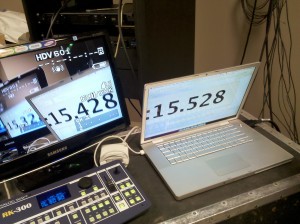No, we’re not talking about some magical Apple device that attaches itself to your refrigerator and allows you to tweet and stream movies to your toaster at the same time… IMAG is short for “image magnification”, and it is the term used to describe the video used at live events to bring you closer to the action when you’re in the cheap seats.
I’ve been in a few places recently where I though they missed the entire point of IMAG, so here are a few thoughts:
Does my venue even need IMAG?
Let’s try to remember the primary purpose of IMAG: To bring the action on stage closer to the audience. There is nothing more distracting in your small venue than your speaker’s face projected 10 feet tall on a screen thats only 20 feet from your audience. If you can already see the stage on the people on it (in reasonable enough detail), most IMAG video is probably overkill. Your video work should add to the atmosphere of whatever even is going on, not overpower it.
There is an exception to this however: use IMAG in small venues when fine detail is needed. If you have very intricate things happening on stage, close up video can make a world of difference. Live performances involving complex music, artwork, visual aids, etc. can benefit greatly from IMAG even if the presenter’s are clearly and easily viewable by the audience.
For example, a few years ago I worked on an event with a tattoo artist on stage in mid-sized venue (300-400 seats). In this case, there really wasn’t a seat so far away that you could not clearly see what was happening. So, a (constant) close up shot on the speaker would have been a bit much. However we had a camera set up and zoomed in on the tattoo, and it produced a dramatic effect. It really did bring the entire effect to a whole new level.
Really, just use common sense. There is a time and place to use IMAG in smaller events, but “just because I can” is not a good enough reason.
What’s “MAG” stand for again?
Now, the oposite end of the spectrum REALLY unnerves me. A few weeks ago, I was at an outdoor event where I was at least 150 yards from the stage. They had a big IMAG screen set up, but in 90% of the camera shots the image was on a 1:1 scale (sometimes smaller) with the stage. Basically, the folks on the screen weren’t any bigger than they appear on stage.
Remember that you are magnifying the image so that your audience can actually feel that they are a part of the action. If your attendees in the upper decks still can’t make out what’s happening on the JumboTron because the image is too small, you’ve just wasted your money. Why do you even need the screens in that case?
